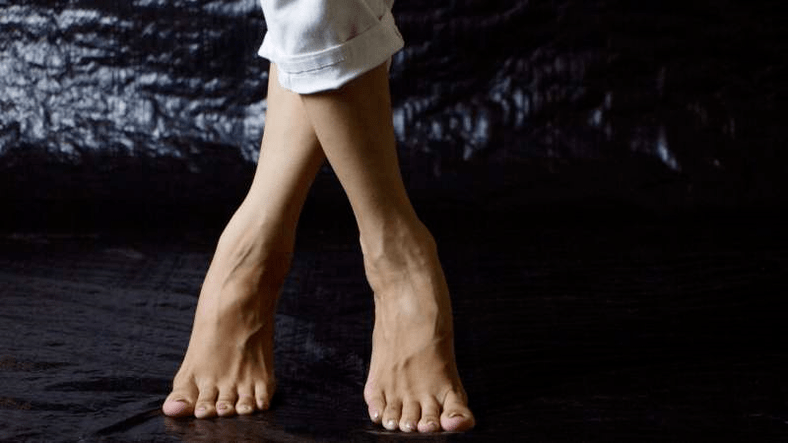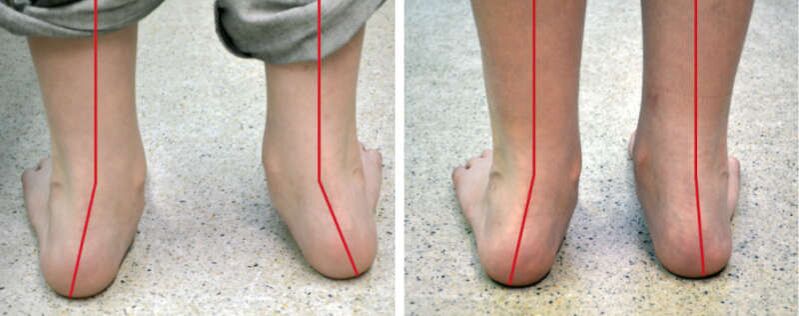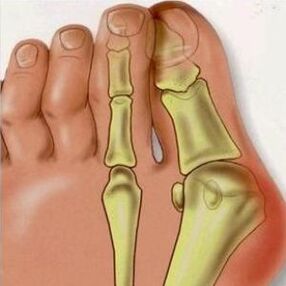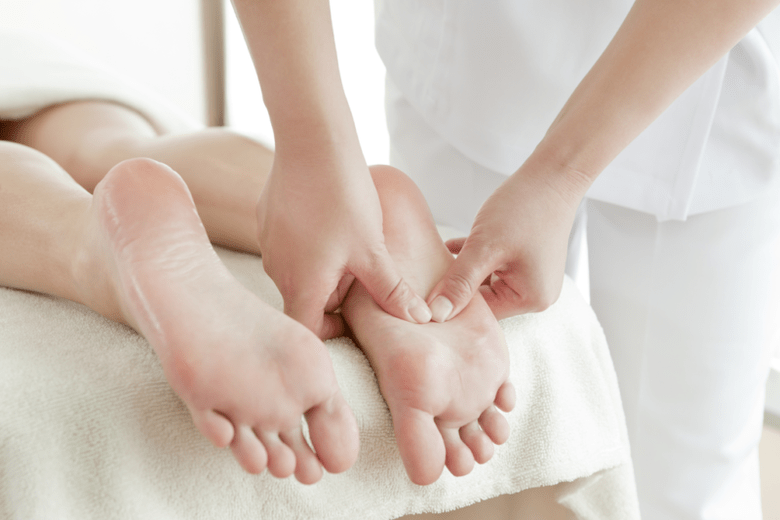This phenomenon is very common and negatively affects the quality of life, so it must talk more about the types of diseases, symptoms, causes and treatment methods.

What is the deformation of the valge?
The deformation of the stop valge is an orthopedic pathology, in which there is a deformation of the most finger -finger -adformation. With him, the first finger (big) on the foot gradually deviates outward, other fingers are deformed. The most characteristic feature of the disease is the development of bishops (growth of bone the venue), the foot increases in a transverse size, which bends inside. The diagnosis is made when several indicators change at the same time: the most characteristic feature of the disease is the development of bishops.
Causes, mechanism
With the deformation of the foot, the joint biomechanics is altered and the bone of the mostneva occurs, which leads to the curvature of the foot. The weakness of the leg connection tissues is guilty of deformation of Valgo. With the deformation of the foot, the joint biomechanics is altered and the bone of the mostneva occurs, which leads to the curvature of the foot. The thumb can no longer look inside and deviate.
In addition, the patient awaits inflammatory processes where the shelf of the bones, bursitis and changes in bone tissues in the first bone area (their head) are observed. All this leads to the wear of the joint, arthritis and osteoarthritis. All this is complicated by the development of calluses and calluses.
Reasons:
- inappropriate shoes (high heels and absence, short or small shoes, narrow foot);
- flat feet;
- Hypermobility of foot joints;
- Short calf muscle;
- Genetics and inheritance;
- osteoporosis;
- working conditions (those who are forced to rest for a long time);
- endocrine system work disorders;
- Overweight.
Guys
There are the following deformation varieties of the feet:
- Static deformation is combined with flat feet and is produced as a result of the spine curvature. The treatment should start with the back treatment.
- The reason for the structural deformation of the feet is an innate abnormality of leg development.
- The cause of the paralitic species is encephalitis or polio.
- The character is developed as a result of the lack of vitamin D and other substances. It is also possible as a consequence of a violation of mineral metabolism.
- The traumatic occurs after ligament or fracture ruptures.
- Spastic deformation develops due to muscle cramps.
- With a compensatory, the tendons are shortened and the shape of the ankle joint changes.
- Hyper -Correctional is developed after inadequate ClubFoot therapy.
- With the deformation of the equine planning of the foot, the march is disturbed, the sole is very curved inward, and after a long position, the person feels severe pain. This disease develops as a result of cerebral palsy and is often found in babies.
- When installing a flat fence foot, it does not have a transverse and hollow disposition.
- The fifth type of valgular deformation develops due to the inadequate location of the foot directly in the mother in the uterus. The front part of the foot is very assigned, and the heel merges visually with the bottom of the leg.

Symptoms at different stages
The disease develops slowly, but permanent, therefore, in different stages of the deformation of the foot valgo, the symptoms will differ.
At an early stage, there are:
- painful sensations when wearing some types of shoes (with a long doubt or narrow shoes);
- The redness of the skin in the area of outstanding seeds.
In the second stage, there are:
- inflammatory processes in the joints;
- pain;
- swelling;
- The growths become more notable.
In the third stage:
- The pain becomes exhausting and sharp;
- In the foot there are calluses or keratinized skin;
- There is a deformation of all fingers and foot joints.
Diagnosis
The main diagnostic methods to determine the deformation of the feet are:
- Clinical inspectionThe orthopedist will appreciate the level of fingers and heels deviations, as far as the arches of the feet soften and how much it moves inside, in addition to the presence of edema.
- X -Ray. It is done standing and immediately in 2 projections. It allows you to accurately evaluate all angles between the joints.
- Ultrasound.
- PlantographyIt will help to determine how big the load is and the stage of the flat feet.
- Computer analysis. Otherwise, a computer's computer study is called postometry and allows you to determine the pressure on your feet.
Treatment in children and adults
If the deformation is not neglected too much, a conservative treatment is used.
Medical Physical Education
It is better to do it in the hospital, but you can at home. Strengthens the foot and helps properly distribute the load on the foot, more improves blood circulation and does not allow edema to develop. The complex recommends an orthopedist, or can deal with the video.
Here are the most effective exercises:
The exercise of the bicycle is effective for the press and hips, but will help the feet

- Bicycle. It is effective for the press and hips, but will help the feet. When you move your leg away, throw your foot forward when you throw foot on yourself.
- Sitting on the floor. We act based on the floor with our hands. We fold out 8 times and extend our legs on the ankle, extend our fingers and return them to I. P. compress and unravel the legs on the legs 6 times.
- In the chair. We move our feet with the fingers forward and backward. You can press the pencil of fingers 1 and second and draw them in Whatman what you like.
- We stretch our legs straight in a chair in a chair and pull the ankle on us until it stops. We fold it and the first maximum finger. After foot, we stretch ourselves and fold our fingers as far as possible. For children, it rises to socks, walking inside the foot will be effective.
It will be useful to walk on any grooved surface, sand, pebbles (not fast) and just along a narrow road. A scooter and a bicycle will be useful for children, because they strengthen the muscles and joints of the foot. Swimming can also strengthen foot muscles and improve blood circulation in it.
Orthopedic devices
Here several devices are used, but they are only selected with an orthopedist:
- Orthopedic shoes. Such shoes must have a hard and high coast, and a special, longer heel from the inside. You must also have a great dissemination that allows you to use it with other devices (corks and pestillos).
- LayersThey can be called for sale by correctors. Overpositions prevent deformations from developing, reduce rubbing and pressure, and do not allow false joint positions to form. Made of silicone.
- Tires. Sometimes they avoid surgery, but with the advanced stages they are not recommended. They firmly fix the joints and allow you to constantly be in a quiet state, relax the muscles and avoid swelling. All this allows the articulation to take a healthy and correct form.
- BandagesThey are used for Halus Valgus, which is similar to tires, but are softer.
- Supinors. Then, otherwise, they call orthopedic templates. These are mechanical supports that correct the distribution of load on the feet and fixing joints. With the deformation of the valgo, transverse, transverse and frame supervisors can be used.
- Interdalizing partitions. They can be called joints, rollers or separators. Facilitate the condition and notice the deformation, but cannot cure dramatically. Normalize march. They can be with locks, made of gel or silicone.
- Orthes and guardians. Such products are necessary with the deformation of valgo from the bottom of the leg or knees. His task is a rigid leg fixation. The heralds for sale can also be called templates, which are previously written.
- Massage carpets. They perform the same functions as any irregular surface in which it is recommended to walk during the disease. Improve blood flow, prevent swelling, relieve pain.
Physiotherapy
His task is to relieve a symptom of pain, prevent stagnated processes in the foot, improve blood circulation and relieve inflammation with swelling:

- Electrophoresis is carried out with calcium preparations, chondroitin with glucosamine, anti -inflammatory and analgesic medications
- Diadinamotherapy. This treatment with electric currents (50-100 Hz frequency). Relieves pain has a myostimulant effect, it improves joint nutrition. In joint treatment, bifurcated electrodes are used. It is contraindicated at high temperature, hypertension, asthma, epilepsy, radiculitis and neuritis, injuries.
- Electrical stimulationThe effect of currents clipped with different indicators allows you to train and strengthen the deepest muscles. Because of this, the foot is strengthened. It is carried out by applying electrodes on the skin. Duration: No more than 2/3 hours, the course is up to 30 procedures. The contraindications are the same as with Diadime therapy plus skin damage.
- ElectrophoresisIn this disease, electrophoresis is carried out with calcium preparations, chondroitin with glucosamine, anti -inflammatory and analgesic drugs. There are no contraindications, but you must choose the right medication.
- MagnetotherapyIt stimulates all cells and accelerates metabolic processes in the joint, used as an auxiliary agent. The electromagnetic field stimulates nerves and muscles.
- Mud applications. Relieve inflammation, swelling and pain. The mud can be sapropelia, hydrothermal and peat, volcanic and sopom. Applied to the feet in the form of "socks" and covered with cloth. Contraindicated in skin lesions and diabetes.
- Ozkerita. The joints are heated and nourished, it stops inflammation. Used in the form of bathrooms or "boots".
- Paraffin applications. Parafine is placed on painful legs. Under it they can apply anti -inflammatory ointment. Relief of inflammation and pain, improve the blood supply. The contraindications are the same as in the treatment of mud and ozkerita.
- Night bathrooms. Relax the foot muscles, relieve pain and inflammatory processes. The most applicable for salt and bathing dirt.
- Acupuncture. It will help eliminate some causes of the development of feet deformation if it is caused by any disease of the nervous or endocrine system: it only needs to act correctly at the right points.
Operational correction
With a deformation that is too neglected of the feet and a trustee covered with weeds, the operation is the only effective method. Around one hundred types of operations are used to treat deformation today.
The most effective are:
The recovery begins on the second day, when the operated can move the fingers
- Surgical elimination of growth (less is that it can grow again);
- balance of periarticular muscles;
- Deformed bone reconstruction operation;
- Joint fixing - atodsis;
- operation to restore ligaments and their correct location;
- implementation of the joint or tendon;
- Operation in the split of the heads of the bones more - exostcctomy;
- The operation to change the angle between the bones and the elimination of the phalanx or more is the osteotomy. It can be Chevarine, proximal or distal;
- Dozens of other operations.
The recovery begins on the second day, when the operated can move your fingers. After 1, 5 weeks, you can start walking, but you can't step on a cooperated area.
It is possible to give a leg load in 4-5 weeks. After 6 months, you can use heels and start playing sports.
During rehabilitation, it is recommended to undergo shock wave therapy, which improves blood circulation in the tissues and reduces edema. The physiotherapy methods described above will be useful.
Popular treatment methods
It is not the best method of correction of the deformation of the feet valge and getting rid of the bone. But you can try.
The compresses are popular.
They use iodine, cabbage sheet, fish (river), aspirin, treemine, snow, castor oil:
- The cabbage sheet can be applied to the affected joint, wrapped in a scarf and go to bed.
- The treason first rubs on the skin, after heating the leg and going to bed.
- Bathrooms with iodine. A teaspoon of iodine per liter of water is needed. On the legs 1/3 hours and grind well.
But the practice shows that the popular treatment of the curvature of the feet is ineffective and can damage.

Prevention
Relapses in this ailment occur, because the weakness of ligaments and muscles is not so simple.
Prevention includes:
- Using the right shoes: natural, without narrow sock and in a small heel;
- Treatment of flat feet in time;
- rest on the legs;
- load regulation;
- relaxing baths;
- Templates or orthopedic supervisors.
What should be shoes?
It is better to ask for orthopedic shoes in special stores and after consulting with an orthopedist.
The shoes should be:
- gentle;
- The sock must be wide;
- Kabluk is required up to 4 cm. ;
- The backdrop and the supervisor must be dense and high (the height of the backdrop 3 cm from the heel).























